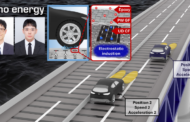A team of researchers, affiliated with UNIST has recently unveiled a hemolysis-free and highly efficient blood plasma separation platform. Published in the May 2021 issue of Small, this breakthrough has been led by Professor Joo H. Kang and his research team in the Department of Biomedical Engineering at UNIST. The research team expects that the new technology will greatly improve the accuracy of point-of-care blood tests, which has shown the increased demand recently.
In their study, the research team used diamagnetic repulsion of blood cells to separate blood cells and blood plasma. Once superparamagnetic iron oxide nanoparticles (SPIONs) are supplemented to whole blood, the SPIONs turn the blood plasma into a paramagnetic condition, and thus, all blood cells are repelled by magnets. The research team collected hemolysis-free plasma without loss of plasma proteins, platelets, and exosomes.

Figure 1. (A) A schematic illustration of the microfluidic device for blood plasma separation using diamagnetic repulsion of blood cells. (B) An image showing red blood cells diamagnetically repelled by permanent magnets.
“Many efforts have been made to develop various blood plasma separation methods. However, there always have been limitations, such as dilution of blood, blood cell impurity in plasma, and hemolysis,” noted Professor Kang. “Our approach overcame these unmet challenges and we could provide a huge impact on in vitro diagnosis once this platform is translated into a commercial point-of-care device.”
The developed blood plasma separation method achieved 100% of the plasma purity and 83.3% of the plasma volume recovery rate without noticeable hemolysis or loss of proteins in blood plasma, which was elusive with the conventional plasma separation devices. Moreover, this method enabled the greater recovery of bacterial DNA from the infected blood than centrifugation and immunoassays in whole blood without prior plasma separation.
“We have overcome the limitations of a filter-based blood plasma separation method that potentially could induce hemolysis or a microfluidic chip-based plasma separation method that has the problems in a plasma recovery rate and purity,” says Research Professor Seyong Kwon in the Department of Biomedical Engineering at UNIST, the first co-author of the study.

Figure 2. Clinical applications of the diamagnetic plasma separation method for biomarker detection.
The research team also developed an ultra-compact, low-cost, high-precision diagnostic chip that can test blood directly without plasma separation. The diagnostic chip detected prostate-specific antigen (PSA) protein, a biomarker for prostate cancer diagnosis.
The developed blood plasma separation method also allowed them to collect platelet rich plasma (PRP). This capability is important because recent studies have revealed that platelets could be used as a biomarker for diagnosis of cancer or diabetes. “Unlike a complex process of the conventional centrifugation method to collect PRP, our method can simply collect PRP by just tuning flow rates,” says Jieung Oh, the first co-author of the study.
This study has been jointly carried out by Min Seok Lee in the Department of Biomedical Engineering at UNIST, together with Professor Joonwoo Jeong and Professor Eujin Um from the Department of Physics at UNIST. The findings of this research have been selected to make the back cover of the journal, Small. This work has been supported by Basic Science Research Program through the National Research Foundation of Korea (NRF) funded by the Ministry of Education, as well as Young Researcher Program by the Ministry of Science and ICT (MSIT). It was made available online in May 2021 ahead of final publication in Small in June 2021.
Journal Reference
Seyong Kwon, Jieung Oh, Min Seok Lee, “Enhanced Diamagnetic Repulsion of Blood Cells Enables Versatile Plasma Separation for Biomarker Analysis in Blood,” Small, (2021).













Pingback: New technology for plasma separation using magnets - newsonetop.com()
Pingback: New technology for plasma separation using magnets - News Online Che()
Pingback: New technology for plasma separation using magnets - newsheadlines4()
Pingback: New Technology For Plasma Separation Using Magnets - Odisha Expo()
Pingback: New innovation for plasma separation utilizing magnets - Mochiter Tech News()
Pingback: New study reveals new technology for plasma separation using magnets – sciencedaily – News Online Che()
Pingback: New study unveils novel technology for plasma separation using magnets - Science Daily - Business Mayor()
Pingback: New study unveils novel technology for plasma separation using magnets | Masoud ILDEREMI()
Pingback: New study unveils novel technology for plasma separation using magnets - AVINASH YADAV()
Pingback: New study reveals new technology for plasma separation using magnets – sciencedaily – newsheadlines4()
Pingback: New study unveils novel technology for plasma separation using magnets » Times of India : The News - Latest Top Trending News()
Pingback: New study unveils novel technology for plasma separation using magnets - Alert Breaking News - United States()
Pingback: New study unveils novel technology for plasma separation using magnets()
Pingback: New study unveils novel technology for plasma separation using magnets - techiai.com()